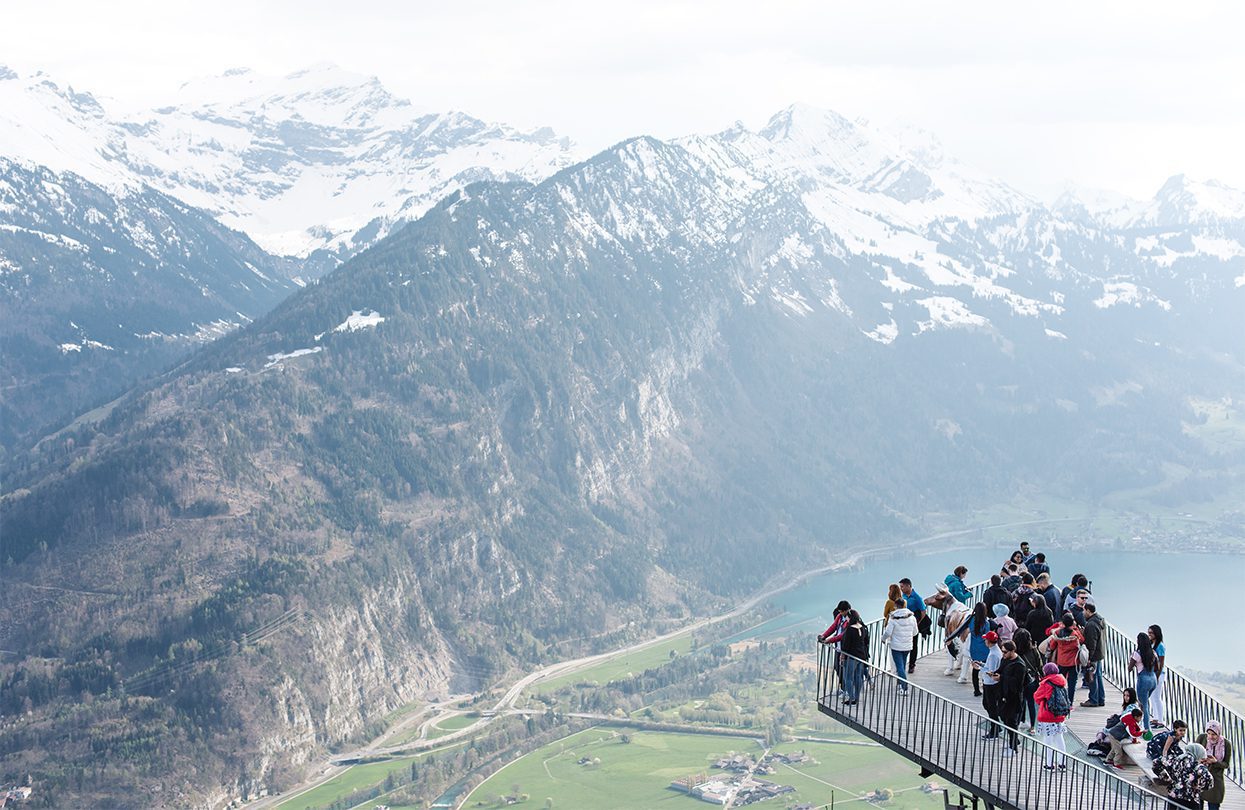[vc_row][vc_column][vc_column_text]Back in 1882, Mark Twain was commissioned by the Chicago Daily Tribune to write a series of letters about his travels through Switzerland, a country the writer and hiking enthusiast held dear to his heart.
In one missive he described the Alps as “if heaven’s gates had swung open and exposed the throne”. Sitting on a sun-drenched terrace at Interlaken it’s difficult to disagree. Positioned between the glassy, serene waters of Lake Thun and Lake Brienz, Interlaken is encircled by a crown of Europe’s highest and most majestic peaks.
The snowy mountaintops of the Eiger (the ogre), Mönch (the monk) and Jungfrau (the virgin maiden, also known as the Top of Europe) loom their jagged fairy-tale perfection concealing millennia of mythology. It is very difficult not to be awed.[/vc_column_text][/vc_column][/vc_row][vc_row][vc_column][vc_column_text]

Cycling around the lake

View of the Lauterbrunnen Valley from one of the many mountain trails
[/vc_column_text][/vc_column][/vc_row][vc_row][vc_column][vc_column_text]The Jungfrau region has long been a year-round destination for holidaymakers of all inclinations – extreme sports enthusiasts, snow bunnies, spa junkies and nature lovers all find blissful appreciation amongst the picturesque mountain villages, lakes, streams, waterfalls and hiking trails. Despite Twain’s insistence on walking or taking a horse and carriage, Interlaken is just a short and breathtakingly beautiful train ride from Bern or Zurich and yet feels as if it’s a million miles away from the concerns of busy city dwellers. As one of Twain’s favourite spots Interlaken has definitely modernised since his time but in essence, little has changed. It is still flooded in “brilliant, life-giving sunshine, full of the suggestion of activity, energy and visible enthusiasm.” This small alpine town with a village-like soul has a veritable cornucopia of things to do while also being the perfect spot to do nothing at all.[/vc_column_text][/vc_column][/vc_row][vc_row][vc_column][vc_column_text]
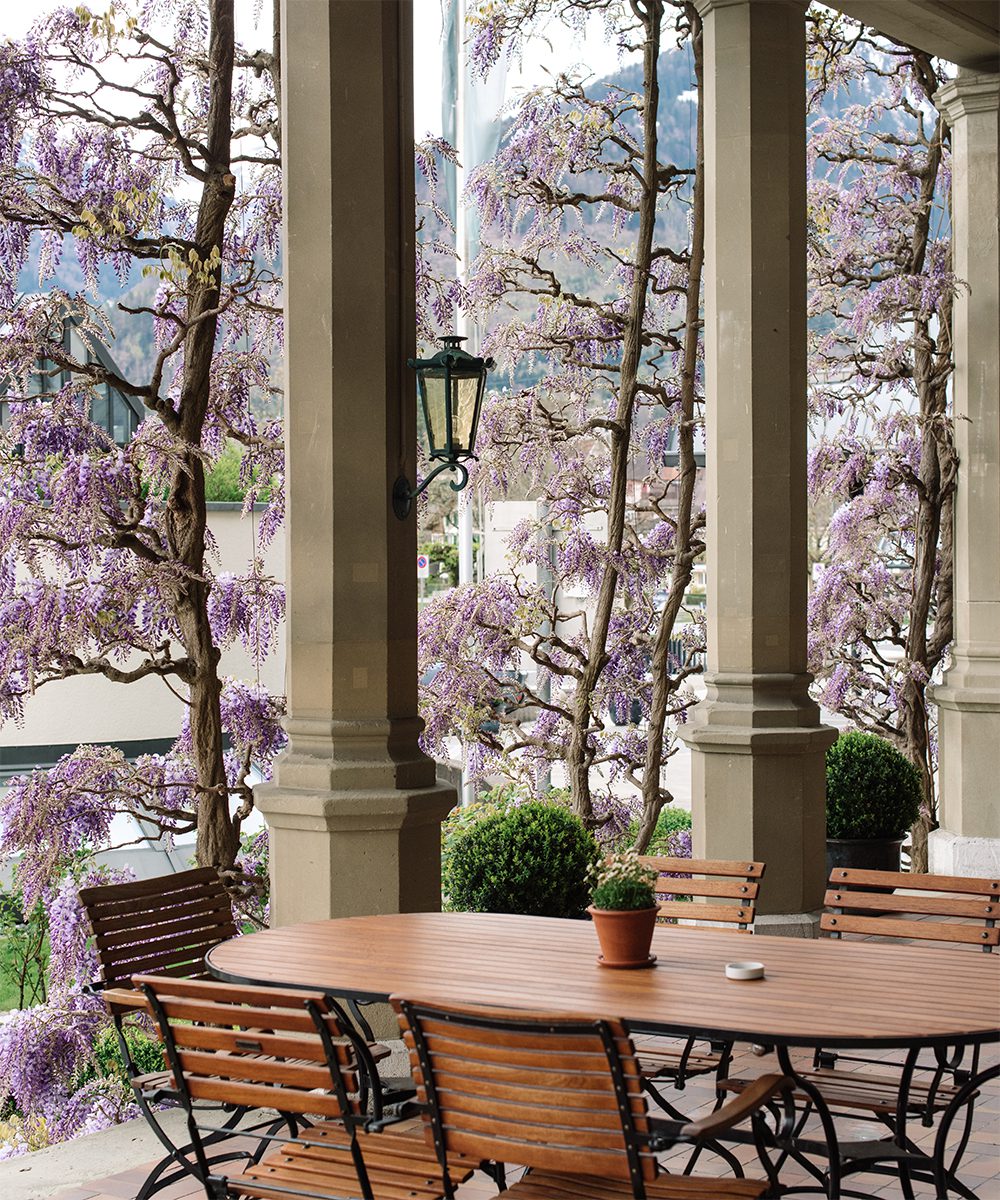
Wisteria blossoms outside the Victoria- Jungfrau Grand Hotel & Spa
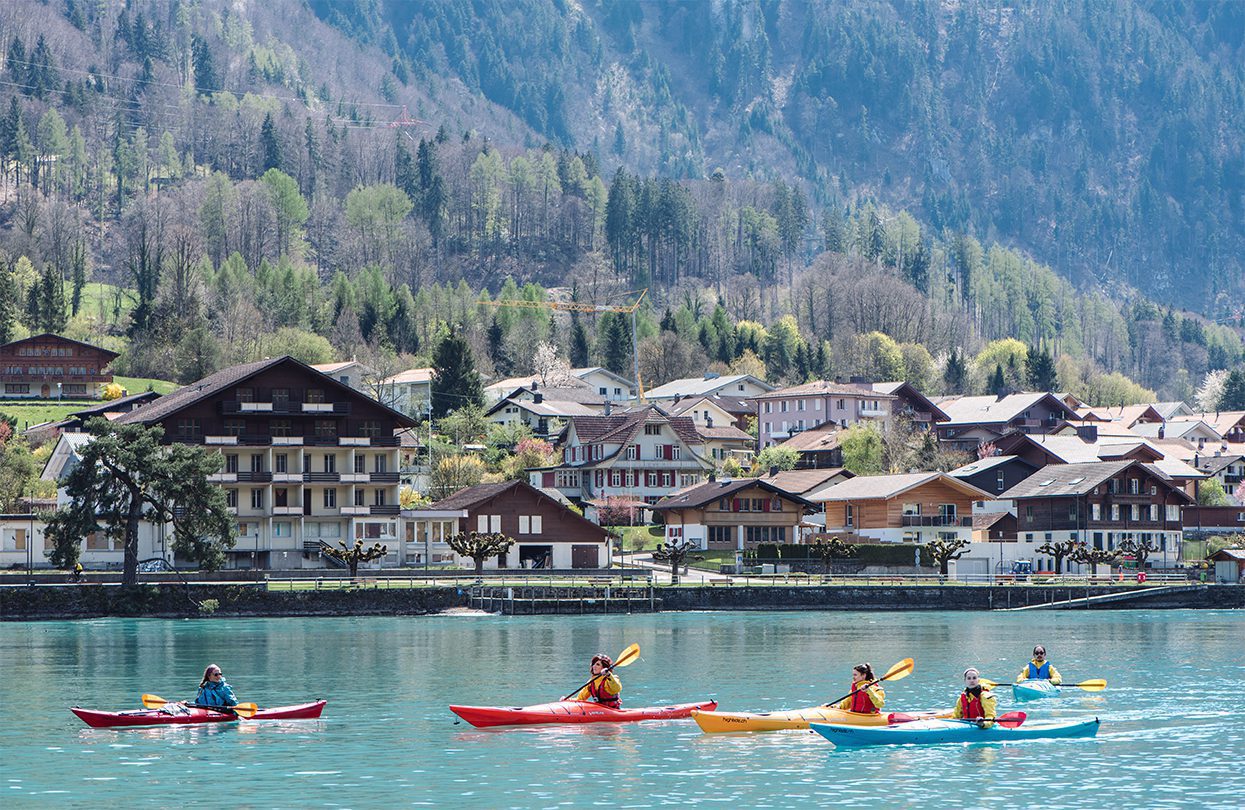
Kayaks on the lake
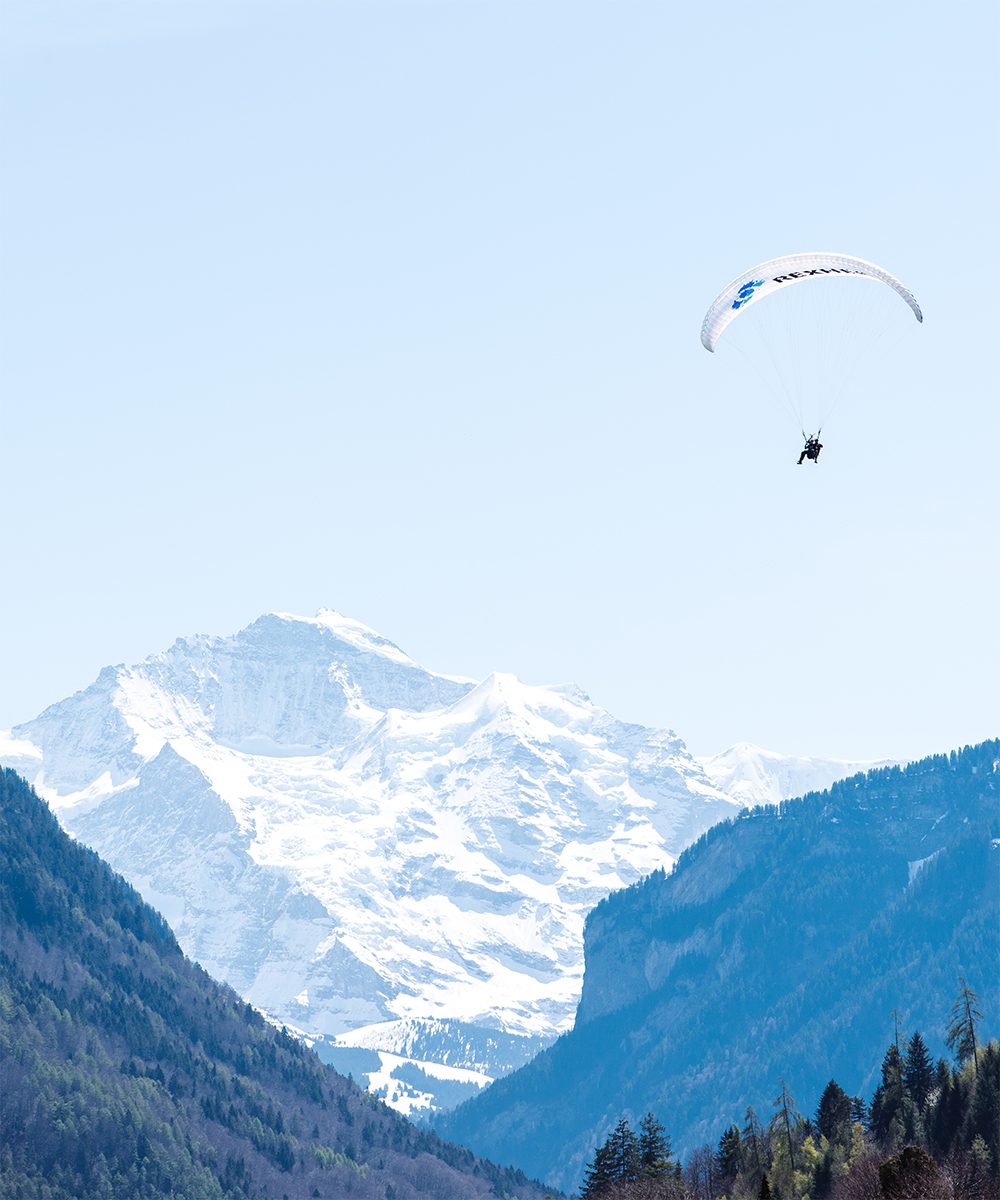
Paragliding over the Alps
[/vc_column_text][/vc_column][/vc_row][vc_row][vc_column][vc_column_text]Twain stayed at the Victoria-Jungfrau Grand Hotel and Spa and it is still the best address in town. This Belle Époque beauty maintains an exquisite romanticism while also providing unrivalled service and state-of-the-art modern conveniences. A plethora of suites are decked out in classic old-world European styles yet still manage to feel fresh and uncluttered. Marble tiled corridors lit by the crisp alpine sun lead to halls topped with Murano glass chandeliers, the tinkling of fountains provides a gentle soundtrack and the overall ambience is of restrained luxury, typically discreet as is the Swiss way. The Jungfrau peak – “the most engaging and beguiling and fascinating spectacle that exists on the earth” according to Twain – sits shrouded in variegated whites across the clipped lawns of the Höhematte Park and it’s possible to spend hour upon hour on the hotel’s terrace soaking up the rays, contemplating the mountain and watching paragliders descend onto the grass like huge, colourful birds.
The thrill of swooping across town in a paraglider is not for everyone so while the more intrepid harness-up others will enjoy a stroll through the pretty streets. Interlaken’s appeal is mostly about the activities available in and around the lakes and mountains but a wander through town will provide some Instagram worthy moments. Höheweg is more of a promenade than a main street and here you can pick up appropriate souvenirs for the folks back home – Swiss army knives from the Swiss Knife centre, chocolate from the Funky Chocolate Club and watches from Bucherer– but keep walking a few minutes more until you reach the sluice gate bridge across the Aare river leading to the medieval town centre of Unterseen.[/vc_column_text][/vc_column][/vc_row][vc_row][vc_column][vc_column_text]
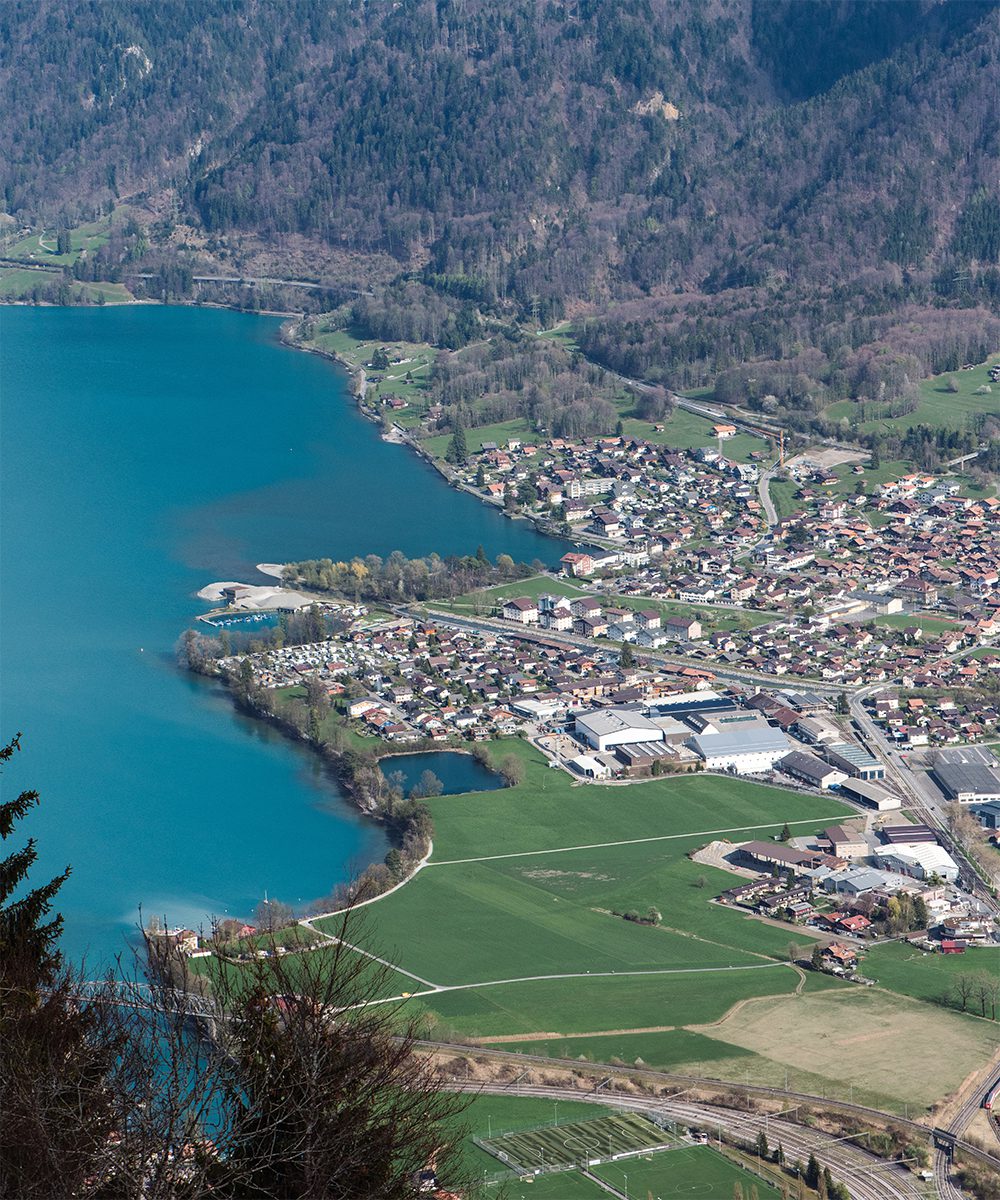
View of Interlaken from Harder Kulm

The halls of the Victoria-Jungfrau Grand Hotel & Spa
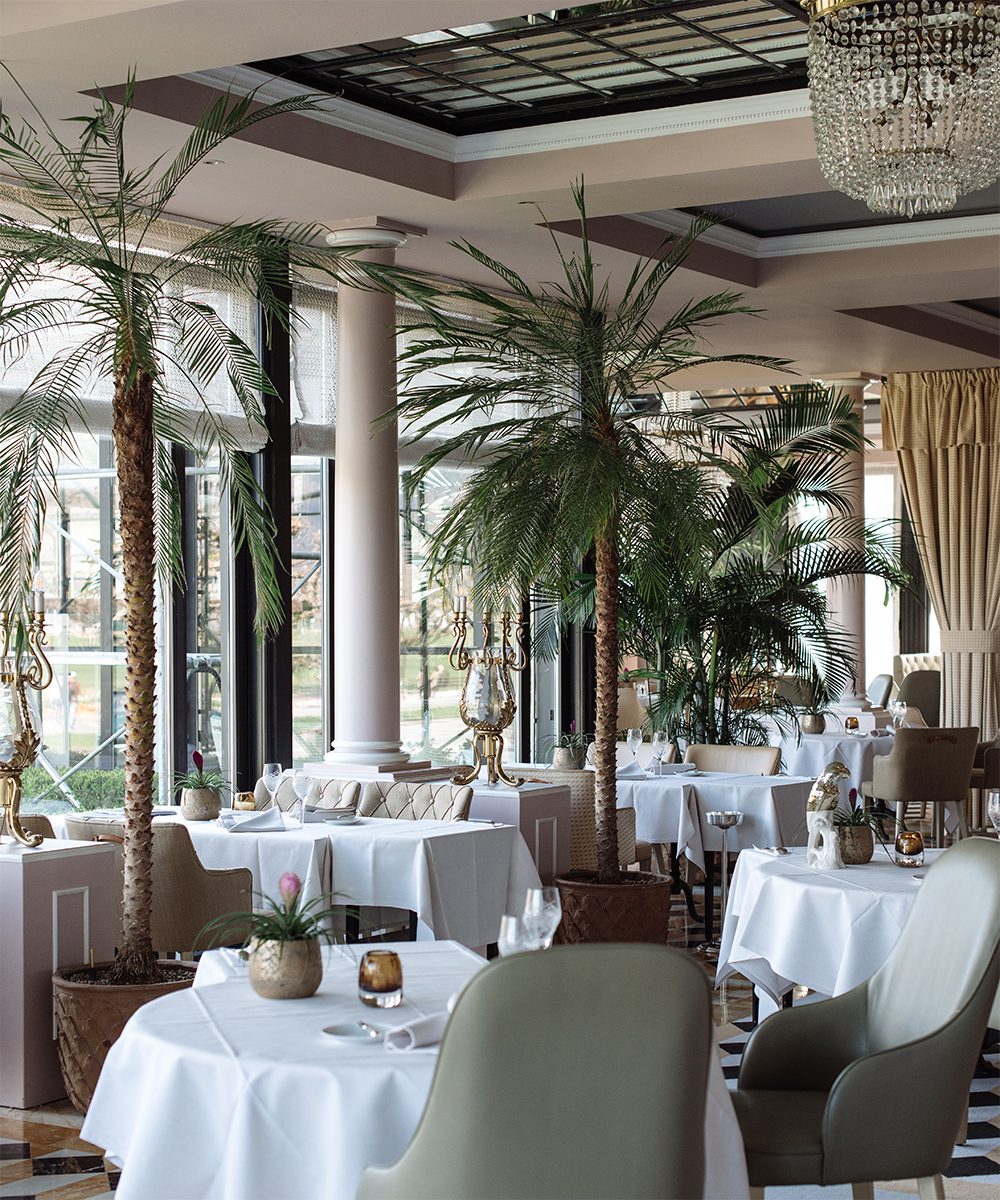
La Terrasse Restaurant interior
[/vc_column_text][/vc_column][/vc_row][vc_row][vc_column][vc_column_text]This gentle walk along the river culminates in the ancient Unterseen old town with its 13th-century church, town hall and the ruins of Weissenau castle. From the Weissenau Nature Reserve, there’s a lesser-known trail through the wetlands boasting impressive views of the mountains. The wooden walkway is blessedly un-crowded and the rippling waters of Lake Thun, vibrant birdlife and delicate wildflowers can be enjoyed in relative peace. Walking, cable car and train are the common modes of transport in the region (the adventurous can add mountain bikes, kayaks, paddle boards and parachutes to that list) but before one embarks on an appreciation of fresh Swiss mountain air one must be suitably nourished.
Restaurant La Terrasse at the Victoria-Jungfrau has been justifiably awarded an impressive 16 points in the Gault Millau guide. Chef Stefan Beeris a local Oberlander and brings a certain regional pride to his menus. Produce is sourced from a strict 40-kilometre radius and Beer uses his local’s know-how to secure the best fresh ingredients from hunters, fisherpeople, farmers and makers. The restaurant’s garden supplies all the herbs plus berries and nuts. Roasted beetroots from Tschingel are served with goat cheese from Meiringen scattered with walnuts from the hotel’s grounds. Oscietra caviar accompanies local pike filet, regional beef tenderloin is served with its marrow and the sorbet between courses is made from Rugen Swiss Cristal gin and tonic.
Beer is not the only chef to prove the innovation of Swiss cuisine beyond fondue and chocolate – although, fondue followed by chocolate amongst the mountains is not such a bad thing. Restaurant Bären serves authentic fondue and other Swiss favourites all set in a traditional Heidi-style wooden chalet. Craft beer enthusiasts should stop by The Barrel and for world-class post-hike hunger-beating sandwiches head to the Sandwich Bar. Don’t miss the excellent coffee and homemade cakes in the Ladelokal café.
Switzerland does not have a reputation as a wine-growing region but once you’ve tasted a few drops of the local selection you might start to wonder if they’ve been keeping it a secret on purpose. Vineyards have been thriving along the shore of Lake Thun in the town of Spiez for thousands of years. The small production is rarely exported making a glass of the local Riesling Sylvaner or Pinot Noir a real treat. A tour of the Speiz vineyards will reveal a deliciously secret side to Swiss gastronomy.[/vc_column_text][/vc_column][/vc_row][vc_row][vc_column][vc_column_text]
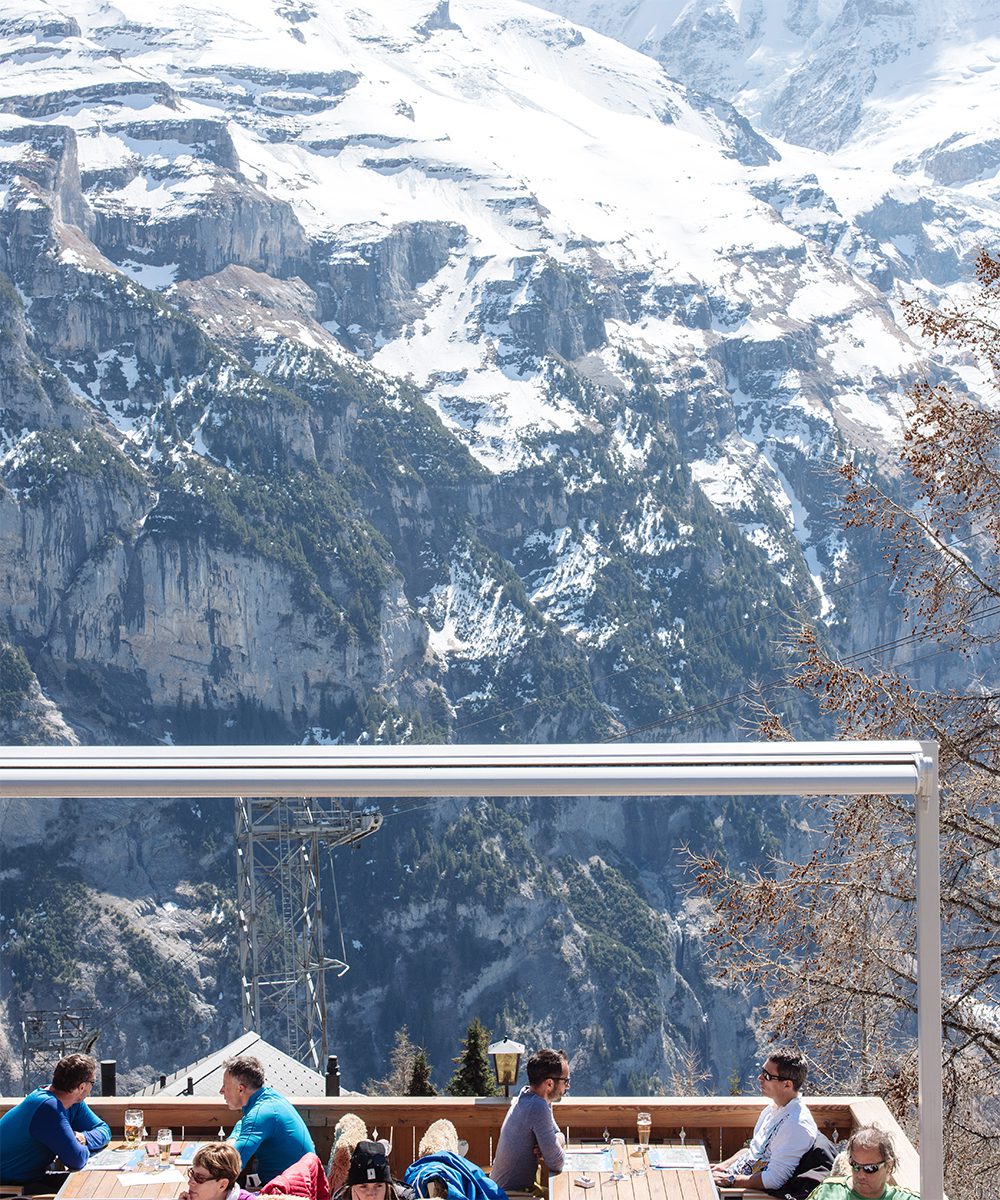
Terrace with stunning mountain views at Hotel Alpenruh in Mürren

Views across Mürren
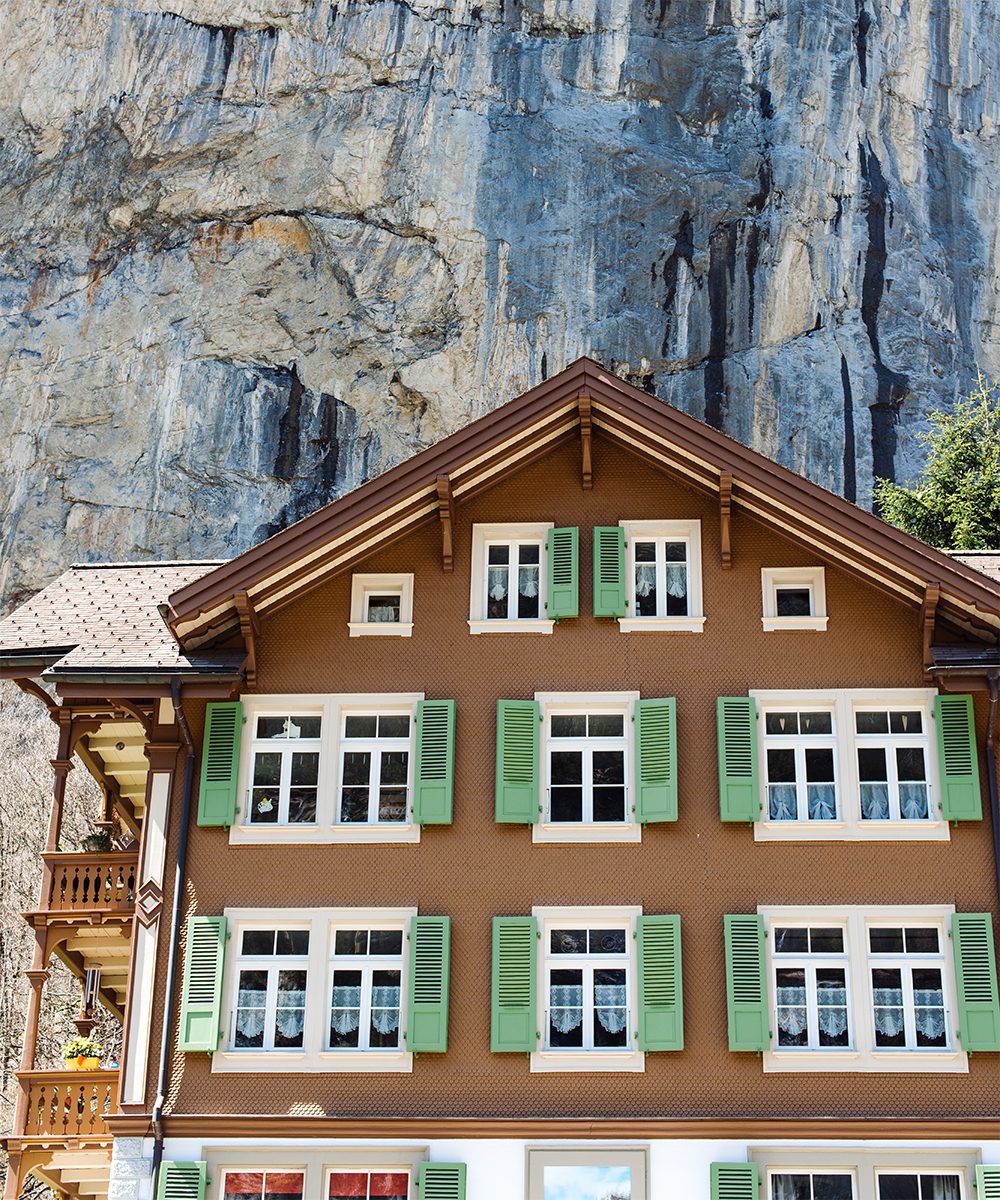
A typical Alpine chalet in the mountains
[/vc_column_text][/vc_column][/vc_row][vc_row][vc_column][vc_column_text]Now that appetites are sated its time to take on the region’s mountains, Jungfrau is composed of a series of cute mountain villages surrounded by lush green pastures, gentle cows and peaked wooden chalets. There are 200-kilometres of well-posted hiking trails serviced by a chain of cog-trains, chair lifts and cable cars all within a 20-kilometre radius of Interlaken. Not even the hardiest hiker will complete every available trail but there are some routes that shouldn’t be missed.
The Lauterbrunnen valley hosts a total of 72 separate cascades the best known is theStaubbachfall located just left above the village of Lauterbrunnen. From Lauterbrunnen train station it’s a relaxed 3-hour hike on a wide flat trail, which can be easily cycled. The falls are stunning, its no wonder Goethe composed “Song of the Spirits over the Water” in honour of the magnificent views. The tremendous Trummelbachfälleare also located on a nearby route. Here, the steep ascent is made easier by a platform elevator and the raging torrent of glacial meltwater will make your heart tremble.[/vc_column_text][/vc_column][/vc_row][vc_row][vc_column][vc_column_text]
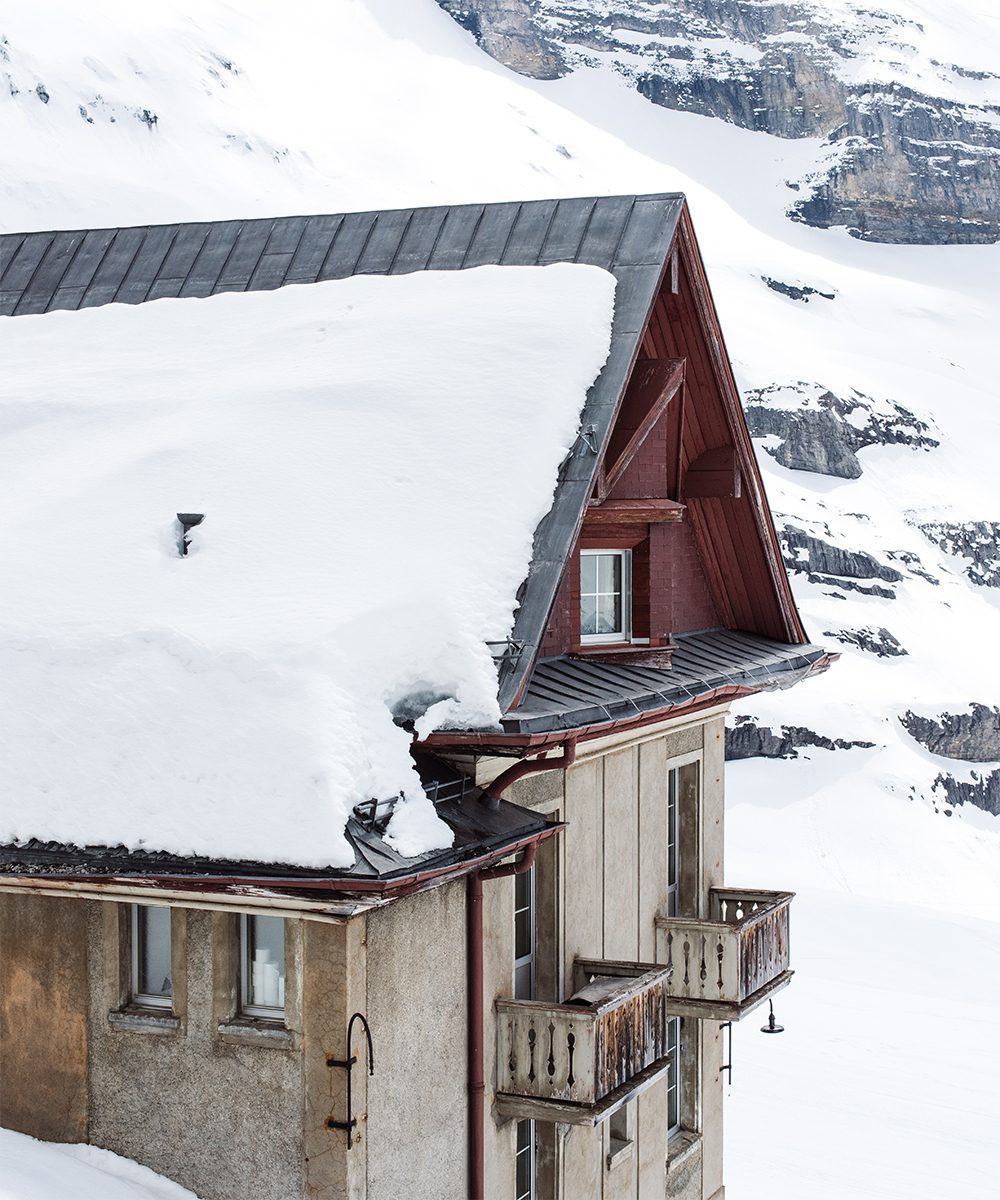
A typical alpine chalet

View from the train to Jungfraujoch
[/vc_column_text][/vc_column][/vc_row][vc_row][vc_column][vc_column_text]The Panoramaweg hike gives it away in its name. An easy to moderate 3.5-hour trek looping from Schynige Platte train station taking you through quintessential Swiss vistas replete with grazing cows, wildflower meadows, snowcapped peaks, the occasional yodeler and impressive views of the two lakes. The Eiger, Mönch and Jungfrau all get a starring role in this stroll through the Alps providing many photo opportunities. Keep an eye out for delicate edelweiss blossoms on this trail and try your best not to break into song.
A journey to the Top of Europe – the Jungfraujoch pass – is essential. The two-hour train ride ascends through near vertical mountain tunnels to 3,454 metres and the station at the top is Europe’s highest. Views of the Aletsch Glacier are astounding and a walk around the ice-palace a must. Be sure to get there early to avoid the crowds and remember a winter jacket – even though you’re in t-shirts down below the Top of Europe is covered in year-round snow.
From here an ultra-fast lift carries you up to the steam-punk style edifice of the Sphinx Observatory. Among its many scientific roles, it also serves as a solar spectrometer for the Institute of Astrophysics and Geophysics at the University of Liège. The words solar spectrometer matched with the buildings unusual sci-fi design is enough to have you dreaming of Hollywood androids. Add in an overnight stay at the Mönchsjochütte, Switzerland’s highest mountain hut, to really seal your adventurer credentials.[/vc_column_text][/vc_column][/vc_row][vc_row][vc_column][vc_column_text]
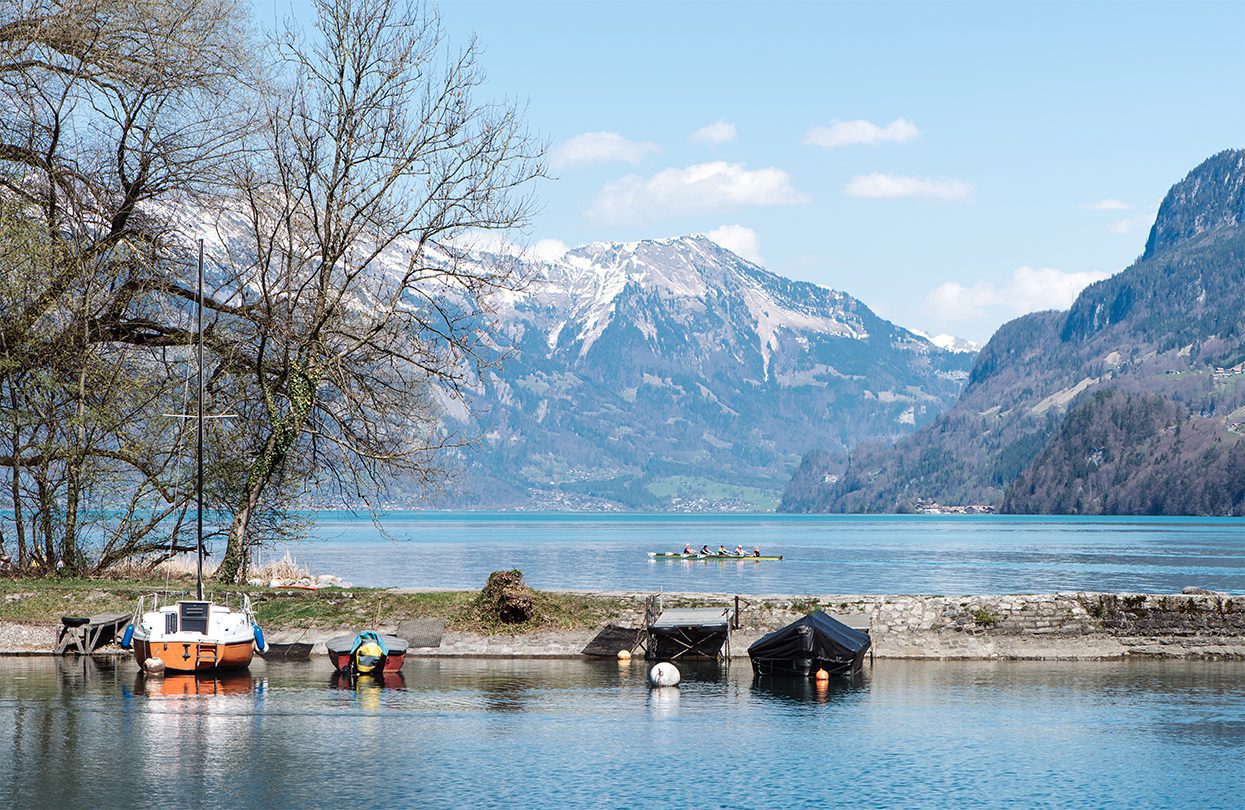
The lakes are a focal point of activity
[/vc_column_text][/vc_column][/vc_row][vc_row][vc_column][vc_column_text]All of the six villages in the Jungfrau region are worth a visit, especially as the transport between them is so efficiently Swiss. Throughout summer, Grindelwald is bedecked in wildflowers growing amongst its chocolate box wood chalets. This petite hamlet looks as if it jumped out of the pages of a storybook. A charming walking route, the Grosse Scheidegg, is quite possibly one of the most beautiful trails in the whole region – which is no easy feat in an area with so much beauty.
Routes along this stretch of the mountain vary from easy to difficult but for those looking for a pleasant stroll ending with schnapps start at Meiringen. This amiable town was the location for Sherlock Holmes swan song and if there’s time, the nearby Reichenbach Falls offer a spectacular view down the rushing torrent towards the valley floor. Take the Postbus to the hotel at Grosse Scheidegg where a gentle climb leads through wild meadows and over small streams running with pristine mountain water.
Views over Grindelwald and the glaciers beyond as well as glimpses of the Sshwarzhorn peak delight throughout this hike. The path ends at the Grindelwald – First gondola where those with no fear can take the First cliff walk across metallic walkways jutting 45-meters over the sheer drop into icy, snowy oblivion. The views here are beyond description. Alternatively, an hour hike from here will take you to Bachalpsee, a glassy alpine lake that shimmers with the reflection of the mountains. We didn’t forget the schnapps, back at Grindelwald village, park yourself on a chalet terrace and order a special supercharged coffee and a Swiss pastry to gather your strength.[/vc_column_text][/vc_column][/vc_row][vc_row][vc_column][vc_column_text]
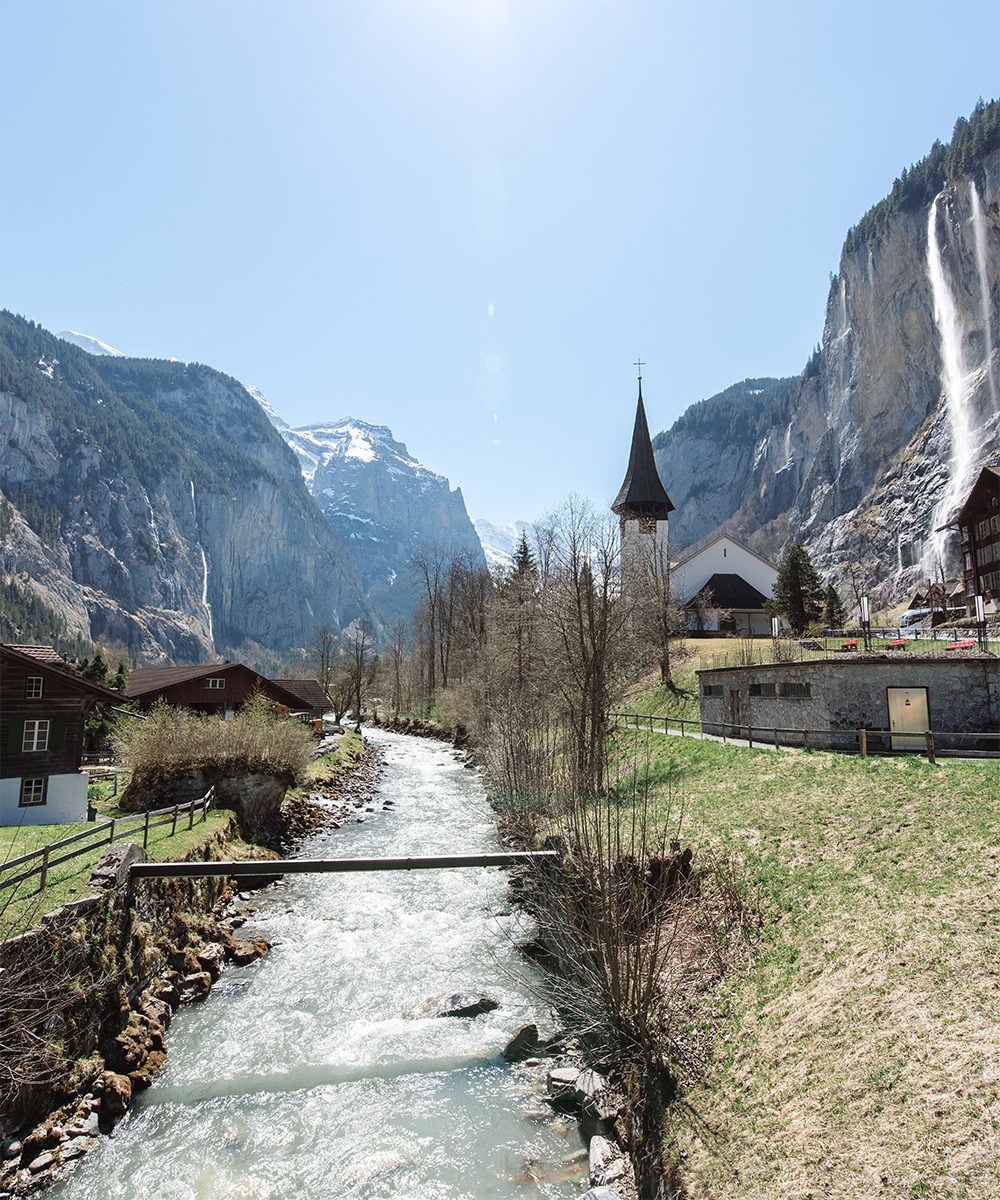
A church glimpsed from the train by the stream at Lauterbrunnen

Jungfrau is dotted with picture-postcard Alpine villages
[/vc_column_text][/vc_column][/vc_row][vc_row][vc_column][vc_column_text]Finally, the village of Ballenberg operates as an open-air interactive museum showcasing Swiss history and perfectly persevered architectural structures from all over the country. There are over 30 workshops where you can have a go at anything from making wooden toys to herbal medicines, cheese making, beekeeping, basket weaving and wool spinning. Grown-ups will be fascinated by the history and opportunity to learn a new skill within a stunning alpine setting but if you’re travelling with children this immersive experience is essential especially the Foxtrail treasure hunt.
With the seemingly endless list of activities on offer throughout the region, it would be ideal to bookend your stay with a spa day (or three, or more) back at Interlaken. The Nescen Spa at the Victoria Jungfrau hotel is a 5,500 square metre ode to wellness encompassing the expected aqua circuit, massage menu and beauty treatments but it’s the signature Better Aging program that makes this spa experience unique. A team of medical staff, chefs and therapists create a bespoke plan just for you. But if you can’t manage to fit a four or seven-day program into your itinerary you can still reap the benefits by dipping in and out of the extensive spa menu. After taking in all that fresh, pristine mountain air followed by some self-care indulgence you’ll emerge a completely new person.
Interlaken and the Jungfrau region come out of the pages of a fairy tale. The dream-like scenery with snow-capped peaks sitting above vibrant green pastures clinking with cowbells, sparkling alpine water and that world-famous Swiss efficiency tick a lot of holiday boxes for families and couples. Holidays here can be as intensely experiential as you have the energy for or as lazy as a mountain cow wandering an alpine path, which is what makes it such an appealing destination.
Mark Twain was the region’s biggest admirer and after a visit, you too will note this corner of alpine paradise as the “charmingest place for repose, and restfulness and superb scenery whose beauty undergoes perpetual, processional change from one miracle to another.” Impossibly magical it’s not important how active you are during your stay because no matter what you choose to do you’ll return to daily life invigorated. By Danni Landa & Photographs By Ana Lui ◼[/vc_column_text][vc_column_text]Subscribe to the latest edition now by clicking here.
© This article was first published in June-July 2019 edition of World Travel Magazine.[/vc_column_text][/vc_column][/vc_row]

